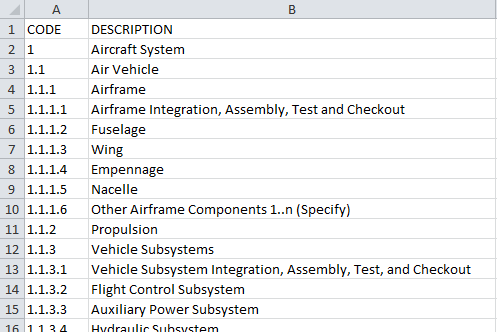 WBS Guidelines for Government Acquisition Programs
WBS Guidelines for Government Acquisition Programs
If you are venturing into the world of government defense contracts, prepare to get familiar with MIL-STD 881D! Here’s everything you need to know about these guidelines, plus some free files to save you time creating your own WBS.
What is MIL-STD 881D?
MIL-STD 881D is the set of guidelines provided by the Department of Defense for the development of a standardized Work Breakdown Structure (WBS).
The principal document in the guidelines is formally called ‘Department of Defense Standard Practice Work Breakdown Structures for Defense Materiel Items’, but you will commonly hear it referred to as the 881 DiD.
Download the MIL-STD 881d PDF or Google MIL-STD 881D to find it on the website of your choice.
What is MIL-STD 881D used for?
The standards are critical in providing the government and contractor with a uniform and consistent approach to a program’s data structure. This assists with good communication between the two parties throughout the lifecycle of the program.
Benefits of adopting the WBS guidelines
The benefits of the standardized approach to WBS creation include:
- Clear segregation of the materiel item into its component parts
- Effective assignment of management and technical responsibilities
- Aid with status tracking for all elements of the program’s cost, schedule and technical performance
- Consistent structure for the earned value management system
Above all else, MIL-STD-881D standard provides a clear starting point for program development down to and including level four of the WBS. At the same time, they provide both unambiguous guidelines and flexibility for program managers below the fourth level.
That means there are no restrictions when working to match the government reporting requirements with a realistic schedule that can be executed by the contractor.
Standard Work Breakdown Structures in government contracting
MIL-STD-881D provides 11 standard work breakdown structures within appendices A to K. Each WBS is clearly defined with a punctuated significant WBS code and description. Each WBS is designated specifically for a particular type of defense system.
Free Download – WBS Structure Files
Save time with our free, ready-made CSV files containing the complete MIL-STD-881D WBS for each of the current defense systems.
Each CSV files contains a simple two-column structure (Code and Description) for easy loading into such tools as Deltek Cobra, Deltek MPM, Primavera P6, Microsoft Project and of course Microsoft Excel.
You can use these as the basis for a new schedule, EVMS code file or WBS Dictionary without having to type them in from scratch.
Click on the links below to download the relevant CSV file you are interested in.
APPENDIX C Missile/Ordnance Systems System
APPENDIX D Strategic Missiles Systems
APPENDIX G Ground Vehicle System
APPENDIX H Unmanned Maritime System

